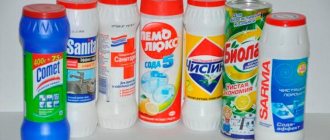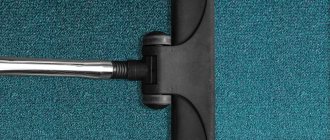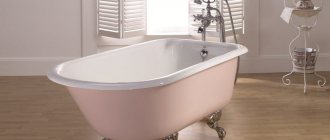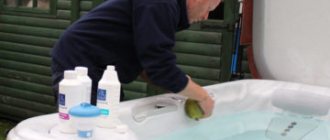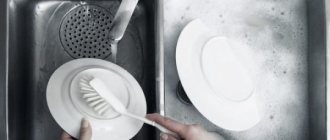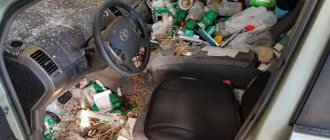Plumbing needs to be kept clean to protect your home from the spread of pathogens. Cleaning the bathroom is not a pleasant task, but modern cleaning products come to the rescue and make the task easier. Let's consider the rating of toilet bowl cleaners for 2022 from leading and little-known manufacturers. Which ones are the best?
Experts' choice:
| Name | Price |
| 1. Sanfor Activ “Anti-rust” | from 70 rub. |
| 2. Nordland Lemon | from 300 rub. |
| 3. PROSEPT Bath Acid | from 95 rub. |
| 4. Amway Home | from 550 rub. |
| 5. Frosch Lemon | from 180 rub. |
Mini rating
Main types of pollution
To choose the right cleaning product, you need to determine the type of contamination.
To eliminate unpleasant odors in the toilet room, any preparations based on chlorine or with fragrances are suitable. The smell appears when microorganisms multiply.
If rusty water comes out when flushing, you need to purchase products containing acid.
When plaque appears on a faience bowl, a product containing alkali is required. Deposits are formed due to increased water hardness.
Reasons for the formation of limescale
Perhaps the most basic reason why this problem can occur is hard water.
Taking into account the fact that water is supplied from rivers and lakes, when pumping out a large amount of soil, debris and microparticles, along with the water, ends up at treatment facilities. And even the most advanced purification technologies do not completely eliminate the presence of calcium and magnesium salts in water. So it is not possible to completely forget about what limescale (urinary stone) is on the toilet.
The only solution to the problem is to install a special distiller. However, the use of such expensive equipment for water used to flush the toilet is completely unjustified.
Naturally, water from the flush cistern enters the toilet, and there, slowly but surely, it provokes the deposition of minerals and other substances, which, as a result, turn into a thick layer of stone.
It should be taken into account that some factors may, to one degree or another, influence the intensity of plaque formation inside the toilet:
- The more often people use the toilet, the more often the water in the tank will be renewed. Accordingly, there will be an excessive consumption of water, and the more it flows down the toilet, the more intense the plaque will be deposited.
- Tank leaking. Its malfunction leads to increased plaque intensity. The more urinary stone that accumulates, the more difficult it is to clean the surface later.
- Interaction with lime is determined by the type of surface. For example, smooth surfaces of plumbing fixtures retain virtually nothing. But in the area of rough areas, the intensity of plaque formation is several orders of magnitude higher. Porcelain toilets suffer most from limescale deposits. On the contrary, enamel-coated sanitary ware successfully resists it.
limescale on the toilet before and after
Types of cleaning products
Types of products
All cleaning products are divided into 3 types:
- chemical;
- preventive;
- folk
Chemicals are powders, gels, liquids. With their help, they eliminate plaque, dirt, and unpleasant odors.
Preventive measures include scented and disinfectant stickers, tablets and balls for toilet bowls.
Folk remedies include cleaning substances that can be found in every kitchen. This is soda, vinegar, etc.
Chemical and prophylactic agents differ in the form of release:
- cleaning powder;
- gel;
- paste;
- liquid.
Powder is one of the most popular means for cleaning plumbing surfaces using special brushes. However, over time, the enamel surface becomes thinner, which spoils the appearance of the earthenware bowl. This should be remembered.
The gel is a universal means for cleaning earthenware plumbing fixtures, as it does not scratch the surface.
Paste is also a professional tool for cleaning toilets, but less popular. Can be used for preventive purposes; it will not cope with large stains.
Liquid products are uneconomical, since to thoroughly clean the surface you have to use a large volume of the product.
Mechanical methods for removing plugs
Another direction in cleaning clogged sewers is mechanical methods, which often solve the problem without the use of chemicals or improvised means. However, it is worth immediately noting that it is mechanically impossible to remove blockages caused by a thick coating of urinary stone or rust - a set of measures is used to clear them.
Cleaning with a plunger
This is a well-known and perhaps the most popular method, which often provides good results. For example, in cases where a plug has formed in a sewer pipe or toilet elbow due to coffee or tea grounds constantly being poured into it.
We recommend: Fum tape: how to wrap it around the thread correctly and how much to wrap it
A plunger that has a nozzle with a cut cone at the end, with a cut diameter of 100 mm, works more effectively.
Most often, a plunger easily copes with breaking through a clogged pipe, if the plug is not old.
When cleaning a drain with a plunger, the toilet bowl must be filled with water. Then the plunger is installed in its drain hole and several pumping presses are made. After this, the device is sharply pulled out of the hole. This procedure is repeated several times if necessary. If the blockage was minor and had not yet “solidified”, after removing the nozzle from the drain, the water will actively drain into the pipe.
Homemade plunger from a plastic bottle
If there is no plunger in the house, and the toilet needs to be cleaned urgently, then a regular one and a half liter plastic bottle will do instead. To turn a bottle into something like a plunger, the bottom is cut off, but the rounding around the hole must remain, that is, only its lowest hard part is removed.
Cleaning drains using a regular plastic bottle.
The process is carried out according to the same principle as using a plunger with a rubber nozzle. The cut side of the bottle is lowered into the drain hole and pressed well against its walls. Then several pressing movements are made, after which the “tool” is sharply removed from the drain.
Using a plumbing cable
Another device that will get rid of the blockage 100% if it has formed in the toilet elbow or in the pipe to the common riser is a plumbing cable. The device is a rigid spring with a handle attached to one side. The cable can have different lengths, depending on the conditions in which it will be used. For autonomous sewerage, a cable 15,000 mm long is sometimes required.
One of the most effective solutions for mechanically cleaning toilet clogs is a plumbing cable.
Cleaning with a metal cable is carried out due to its flexibility and ability to move into the sewer pipe to a considerable depth through curved sections.
Using a cable with a spiral attachment at the end, you can try to pull out foreign objects that, for example, a child threw into the toilet
The work is carried out in the following order:
- The end of the cable is lowered into the toilet drain until it hits the resulting plug.
- Then you need to start slowly rotating the handle, pushing the cable inside the pipe. As it moves forward, the cable will move the blockage.
- The final step of this procedure is to flush the pipes with hot water with the addition of technical soda.
If there is no cable, then you can try cleaning it using a rigid but flexible cable, the main thing is that it has the required length and diameter. It is pushed into the sewer pipe through the toilet, turning it periodically. Thanks to such actions, you can destroy the plug blocking the pipe, or push through an object stuck in the pipe or elbow.
Cleaning with a cable should be carried out with special care if the toilet is connected to the sewer pipe by thin-walled corrugation. It doesn't take much effort to break through such a wall.
Check out the types of grease traps for sewage and their installation from our new article on our portal.
Film plunger
In South Korea, a special high-strength film-plunger “Pongtu” has been developed, produced and supplied to the Russian market, which can be easily used for any size toilet.
Clearing a clogged toilet using a special film plunger. The process occurs without unpleasant splashing of water on the sides
The film is glued to the top of a toilet bowl filled with water, and then pressure is applied intensely and rhythmically with both hands. Thus, this device operates on the principle of a plunger, but there are no splashes flying in different directions or even in the face, which often happens during normal cleaning.
If you come across such a set of two films on sale, it would be a good idea to purchase it for an emergency.
The kit comes with two disposable films and is a good idea to have on hand in case of unexpected clogs.
Which brand of toilet cleaner should I choose?
Surveys and customer reviews show that the most popular are advertised products from leading manufacturers. However, it is worth taking a closer look at little-known companies in the chemical industry, since their products are not inferior in quality to branded ones.
Domestos detergents
Domestos is a widely used detergent produced by Unilever. Using this gel, you can destroy all microbes that are located in hard-to-reach places in the toilet. In addition to the gel, the company produces preparations for blockages and to remove limescale.
Brand Toilet duckling
Toilet duck is another brand. It can continue the list of the best drugs, as it copes even with old deposits. The thin spout of the bottle allows you to apply the gel right under the rim of the toilet bowl.
Russian company Grass
Grass is a well-known Russian company producing auto and household chemicals. The company produces products using patented Italian technology, which guarantees high quality and an appropriate level.
Russian company Synergetic
The Russian company Synergetic produces high-quality biodegradable products, which makes it very popular. The drugs can be purchased at all major chain stores.
Bref Company
Bref products can be found in every household goods store and are a popular high-quality brand.
German company Frosch
Frosch is an equally well-known German company for the production of household chemicals; toilet disinfectants help get rid of deposits and bring plumbing fixtures to perfect condition.
Chirton
The calling card of the Russian brand Chirton is a range of bright scents that create a cozy atmosphere in the bathroom and toilet room.
Kobayashi is a little-known premium Japanese brand. It is worth taking a closer look at this product, as it guarantees perfect cleanliness of the bathroom.
Recommendations
When starting to clean the toilet, you must follow the following recommendations from cleaning specialists:
- All work must be carried out wearing rubber gloves;
- to protect the respiratory tract from caustic fumes, you will need a mask;
- for regular surface treatment, it is recommended to use preparations in gel form, as they damage the material of the toilet bowl less and dissolve better in water;
- cleaning the toilet must be supplemented by washing the lid and seat;
- in extremely advanced cases, repeated treatment may be required if the complex plaque was not eliminated the first time.
Sources
- https://samyiluchshiy.ru/top-luchshih-sredstv-dlya-chistki-unitazov/
- https://sovet-ingenera.com/santeh/unitaz/chem-prochistit-zasor-v-unitaze.html
- https://ExpertVybor.ru/luchshee-sredstvo-dlya-chistki-unitaza-01/
- https://septikexpert.com/vidy-kanalizacionnyx-rabot/prochistka/sredstvo-ot-zasora/
- https://santatrade.ru/chem-luchshe-vsego-ochistit-unitaz-ot-izvestkovogo-naleta/
- https://vyborexperta.ru/byt-i-uyut/luchshie-sredstva-dlja-chistki-unitaza/
- https://yborka.online/uborka/rzhavchina/na-unitaze/luchshee-sredstvo-dlya-chistki
- https://rio-restoran.ru/dlya-uborki/sredstvo-dlya-chistki-unitaza-ot-rzhavchiny.html
- https://sandizain.ru/uxod-i-sanitariya/zasory-i-prochistka/kak-ochistit-unitaz.html
- https://poleznii-site.ru/dom/byt/chem-otmyt-rzhavchinu-v-unitaze-narodnye-i-spetsializirovannye-sredstva.html
- https://KatalogPoleznogo.ru/dom/rzhavchina-v-unitaze-30-sposobov-udalit-podteki.html
- https://sdelai-lestnicu.ru/uborka/kak-pocistit-unitaz-20-lucsih-narodnyh-i-himiceskih-sredstv-ot-izvestkovogo-naleta
- https://stroyday.ru/remont-kvartiry/ustanovka-i-remont-santexniki/kak-prochistit-unitaz-ot-zasora.html
Did the article help you?
How to choose the right drug
How to choose the right drug
Drugs are created based on active substances:
- abrasives;
- alkalis;
- acids;
- chlorine.
An abrasive is a powder substance that mechanically cleans a surface. You have to use a large amount of powder to clean lime deposits in the toilet and sink, and microdamage to the surface is also possible. It is inexpensive, which is why it is popular.
Alkali copes with rust and protects against urinary stones - if you use the product for daily preventative cleaning. Does not remove old lime deposits.
Acid is a powerful tool for eliminating various types of contaminants - deposits, rust, urinary stone, etc. The product must be used with great care, as the acid has a pungent odor and causes burns on the skin.
Preparations with chlorine are also effective against any dirt and deposits.
Call a plumber
If none of the methods have solved the blockage, and the water continues to stand in the toilet, you will have to turn to professionals who will solve the problem or determine that the toilet will have to be replaced. The last option is inevitable if the plumbing accessory is old and the drain hole has managed to become covered with a 15-20 mm layer of urinary stone, due to which the contents of the toilet bowl do not go into the sewer. It can only be removed by breaking the toilet.
If the cause of the obstruction is related to the formation of a dirt plug or a stuck object, then using special equipment, a plumber can easily cope with the problem.
Calling a plumber with special equipment will solve problems in serious cases.
The master can also determine that the local sewer system has nothing to do with it, and the reason lies in a clogged riser. However, the latter option can be determined without a plumber, since the problem of blockage will arise not in one, but in several neighboring apartments using the same riser.
The most effective tablets and blocks for cleaning the toilet
Nagara
Nagara tablets
Five tablets for toilet disinfection, RUB 195. Organic and inorganic acids.
Disinfection, removal of lime deposits and stone.
Place the tablet in the toilet, leave it until the morning, then wipe it with a brush.
Advantages and disadvantages
Effective removal of all types of dirt and bacteria
Long wait for results
Tablets are good if you don’t urgently need to clean the toilet. They smell nice and create a protective film.
Liaara Sea freshness
Cleaning tablet Liaara Sea freshness
Cleaning tablet, 2 pieces, 50 g each, cost 53 rub. Organic and inorganic acids, fragrance.
Creates abundant foam, protects against bacteria, eliminates odor and refreshes, prevents the deposition of stone and lime.
Put it in the tank
Advantages and disadvantages
Easily keep your washroom clean and fresh
destroys germs
Does not protect against rust stains
Economical consumption, two tablets are enough for a month. Always neat and clean toilet.
Toilet duck – toilet block Citrus breeze with orange scent
Toilet duck – toilet block
Hanging hygienic block, 144 RUR. Surfactants (surfactants).
Pleasant smell, protection from lime and stone deposits.
Hang on the toilet rim
Advantages and disadvantages
Lasting aroma
antibacterial protection
Does not protect against rust stains
The aroma lasts for a long time, ensures hygienic cleanliness, and lime is not deposited.
SANinspector Ocean
Tablets SANinspector Ocean
Tablets with active protection against lime, 3 pcs., Benzanate and sodium dodecyl sulfonate
Freshness, protection from lime and rust stains.
Place in the drain tank.
Advantages and disadvantages
Protection against bacteria and odor
colored water
Does not remove old lime deposits
Pleasant marine aroma, the tablet lasts for a couple of weeks, there is always a fresh atmosphere in the toilet room. Great choice.
Preventive control measures
Everyone knows that preventing pollution is much easier than looking for means to combat it. In order to prevent lime and urinary stone deposits from spreading, you need to use several tips:
- Adjust the drainage system so that water does not constantly flow into the bowl from the tank. This will help not only prevent the appearance of limescale, but also ensure economical consumption of water resources.
- Do not flush fat and other food debris down the toilet; they contribute to the appearance of new growths on the surface of the toilet.
- Every time after use, go over the bowl with a brush, cleaning it from organic contaminants.
- Use preventive soap substances that are added to the tank or attached directly under the toilet rim.
If you keep your toilet clean, there will be no need to use harsh chemicals. With proper care, your ceramics will remain sparkling clean for a long time.
Potent acids
Sometimes you come across plumbing fixtures that no one has used for a long time, for example, apartments in old houses or offices in abandoned enterprises. Of course, you can buy a new toilet and not think about how to clean the rarity. If this cannot be done, then strong acids are used.
- Hydrochloric acid with a concentration of at least 35% is an aggressive product, but it cleans the strongest and oldest stains. It should be used with gloves and with windows open; inhalation of vapors causes burns and an allergic reaction. To keep the enamel intact, do not soak the acid for more than 15 minutes, then rinse it off with water several times. Leave the windows open until the smell evaporates completely.
- Electrolyte - used in metallurgy, medicine, industrial production, or to remove stubborn stains, including limescale from toilets. The action occurs due to sulfuric acid, which corrodes contaminants. As with hydrochloric acid, you need to use a mask and rubber gloves. Leave on the enamel for no more than 10 minutes, then wash off.
- Orthophosphoric acid - can be used on polymer surfaces. If plastic pipes are installed, pour in the product for 10 minutes, then clean with a brush and rinse off. It fights well against rust in the flush cistern and in the toilet bowl. We use gloves when working.
- Oxalic acid - pour thickly inside the toilet bowl and wait an hour, then clean and flush. If the plaque is not completely removed, you can repeat the cleaning.
Preventing the appearance of limescale
If you wash your plumbing fixtures regularly, dirt deposits will still appear. But the layer will be much thinner, and then you won’t have to use aggressive chemicals for cleaning.
Follow a few simple rules:
- Install high-quality plumbing fixtures, not necessarily expensive ones. The surface of the toilet bowl should not contain micropores, cracks or chips.
- Use softener tablets and toilet bombs. Dissolving in the tank, they soften the water and help fight mineral build-up.
- If you live in a country house, install a system of coarse and fine filters, as well as a water softener coming from the well.
- Give the toilet a good, wet cleaning regularly - at least once a week. The more people use the toilet, the more often it needs to be cleaned.
- Use a brush after visiting the toilet and constantly remove any dark deposits that appear.
